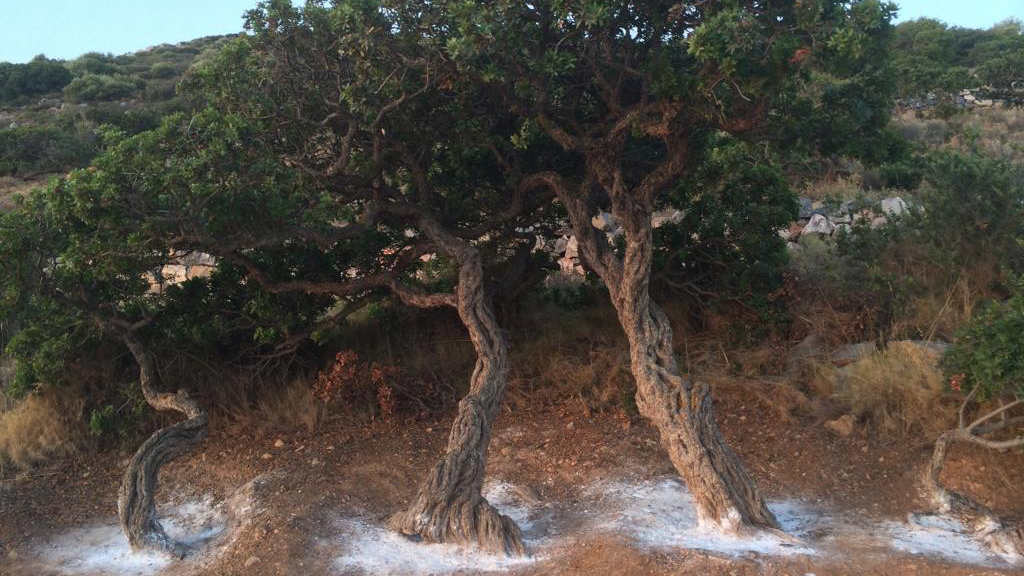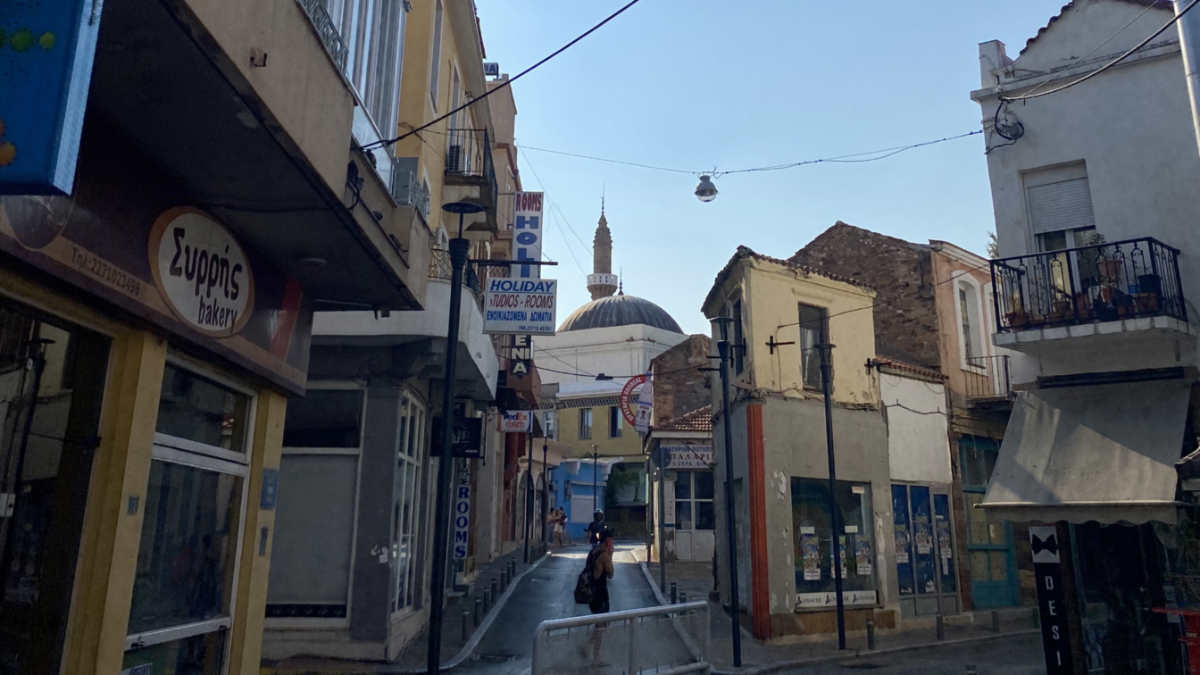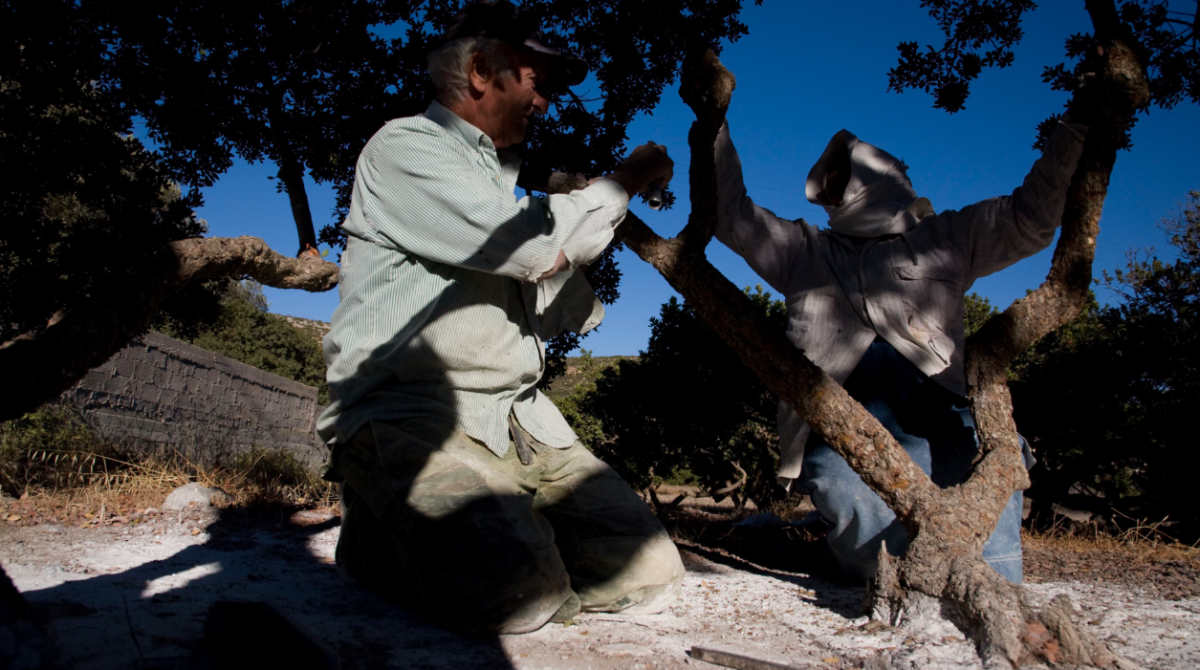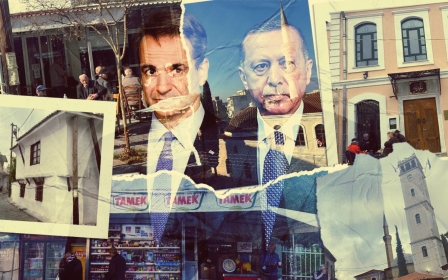Chios, the Greek island fuelling the Arab world's sweet tooth
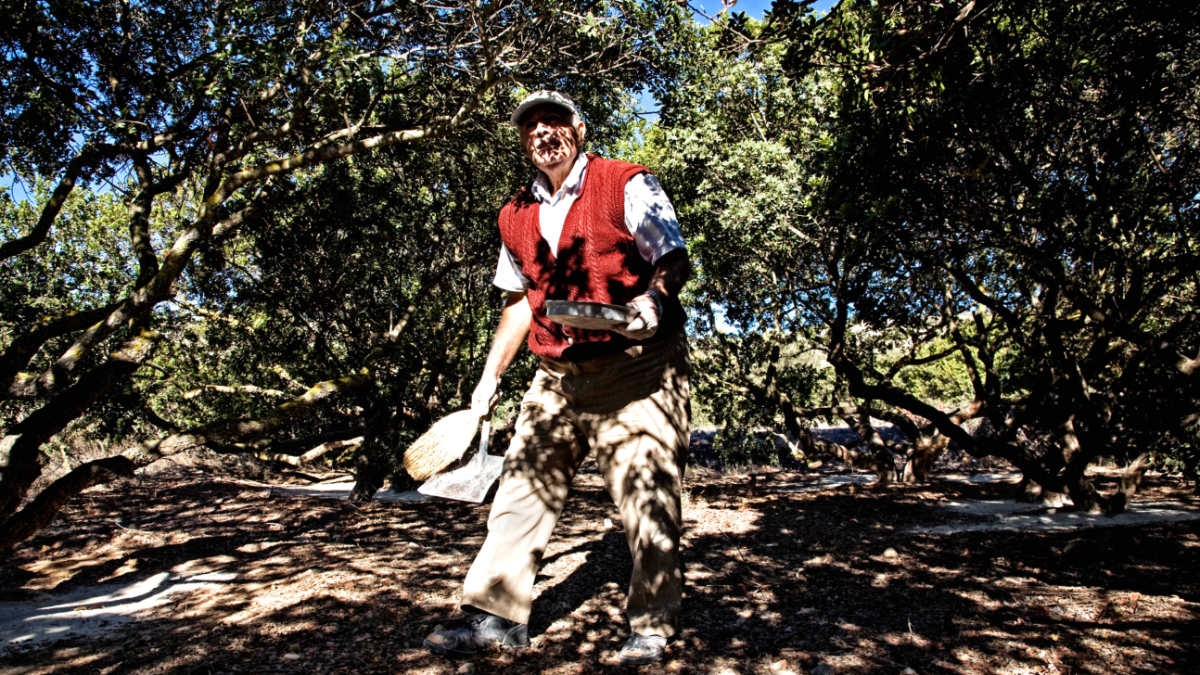
At first glance, the shaded, cobblestoned plateia (central square) in the medieval village of Kalamoti on the Greek island of Chios, seems far removed from the bustling streets of Amman, Jordan.
The town square of this Aegean island is nestled inside a honeycomb of small, bougainvillea-scented alleys, where stone houses are connected by arches and passageways.
Xenophon Moniaros is seated comfortably at the plateia outside Stefanis Kafeneio (cafe), with a small, thimble-sized cup of syrupy Greek coffee.
“We make the coffee stronger here,” Moniaros, a local historian, says nodding at the white Loumidis brand coffee cup, which is standard fare at old-school cafes across Greece. “In Kalamoti, the coffee has a kick, more like the Middle East.”
The caffeine is a welcome boost for Moniaros, who was up early in the morning to check on his mastic trees. Kalamoti is one of 24 Mastichochoria, or mastic villages, of southern Chios, the only place in the world where the rare, cedar-flavored resin of the same name is cultivated.
Stay informed with MEE's newsletters
Sign up to get the latest alerts, insights and analysis, starting with Turkey Unpacked
Once it is collected, the mastic from Moniaros' trees is shipped across the Mediterranean to port cities like Aqaba, Beirut, Jeddah, and Dubai. One of its final destination points is Bekdash Ice Cream in downtown Amman, or Wasat al-Balad.
“Of course, we know Chios,” Hamzeh Ababneh, whose family owns the ice cream chain with eight locations across Jordan's capital, told MEE. “It is the secret island of mastic. If it wasn’t for Chios, we wouldn’t have booza.”
Booza is a chewy ice cream that originated in the Levant, or Bilad al-Sham, a region of the Eastern Mediterranean comprising, Syria, Jordan, Palestine, and Israel. Unlike other ice creams, booza has a unique stretchy texture, similar to Turkish dondurma, which also contains mastic.
'Nothing can stop the flow of mastic. Not a war or sanctions'
- Talal Arar, Dubai-based Mastic distributor
The street life outside the brightly lit Bekdash ice cream parlour in Wasat al-Balad is more animated than Kalamoti. Biceped men with wooden cudgels rhythmically pound chilled metal bins of booza. They roll the elastic white slabs like cigars before dunking them in buckets of crushed pistachios.
Outside, families jostle for a seat on the curb with paper plates of kanafeh, and young people cruise by in cars blaring Arabian pop hits. Those with stamina can order a cheesy Palestinian desert from a food stall called Habiba and then go to neighbouring Bekdash to have it topped off with a mound of booza.
Mastic and sahlab, a flour derived from orchid root, are two of booza’s key ingredients.
“It’s where the flavour comes from,” Ababneh says. It’s also one of the trickiest parts of the recipe to get right.
Mastic is mainly sold in hardened crystal form. At Bekdash Ice Cream, it is liquified by grinding it with sugar at 60-80 Celsius. Ababneh says the exact temperature, like the amount of mastic, is a company secret.
“You can’t add too much mastic,” he tells MEE. “First, it’s expensive. It costs about 160-200JD (about $255) a kilogram in Jordan. Some people think if you overload the mastic, the flavor becomes sweeter, but it becomes bitter.”
Mastic ice cream was first popularised in Damascus, Syria, when the original Bekdash in Souk al-Hamidiyeh opened its doors in 1895. The ice cream shop has operated throughout Syria’s civil war, importing Chios mastic via Lebanon, traders told MEE.
“The Arab people love mastic,” Talal Arar, one of the Middle East’s largest mastic distributors, originally from Damascus, said. “Nothing can stop the flow of mastic. Not a war or sanctions,” Dubai-based Arar added.
Of course, mastic’s usage extends beyond ice cream.
Mastic from Aleppo to Raqqa
The resin is listed as an ingredient in the medieval Arab cookbook Kitab al-Tabikh. Adding mastic to arak, an anise alcohol drink similar to Greek ouzo, was a craze in the early days of Saddam Hussein’s Iraq.
“Mastic was the product in Iraq during the 70s and 80s,” Arar said. “Chios made a fortune off of Iraqis taste for arak.”
In the Levant, mastic is added to sweets like baklava and meat marinades. Libyans import Chios mastic to flavour stuffed intestines, while Saudi Arabians add it to saleeg, a rice and meat dish, and burn it as incense. In Turkey, mastic is a popular coffee flavor. Mastic chewing gum is popular across the Arab world. The Greek word "mastic” comes from the ancient Greek word mastichon, to chew.
About 85 percent of Chios mastic is exported abroad, with the Middle East and North Africa as the top destinations.
Despite being the sole place in the world where mastic is cultivated, Chiotes, island natives, use the product sparingly. Kronos, a local brand, makes its own mastic ice cream, called Kaimaki. One of the most popular mastic products in Greece is a sweet liqueur, served chilled, called mastiha.
“The Genoese and later Ottoman powers that controlled Chios wanted as much mastic shipped abroad as possible, so it didn’t catch on here as a culinary tradition like in the Arab world,” Moniaros said.
The Sultan’s court, particularly the harem, had a ravenous appetite for mastic. So much in fact that Chios' 24 Mastichochoria and their crop were placed directly under the control of the Sultan’s mother, the Valide Sultan, John Contoudis writes in Chios: A History (2010).
“The rest was sold to Aleppo, Alexandria and even Raqqa. Two-thirds of mastic production went to the Arab East,” Moniaros added.
The spread of mastic was aided by Chios’ central location on trade routes between Black Sea ports like Odesa (Ukraine) and the Levant. The island’s wealth, and strategic location between East and West, made it a prize in the Mediterranean’s geopolitical chessboard.
In the 1300s, the Genoese took control of Chios from the decaying Byzantine Empire. They ruled the island like a fiefdom, exploiting mastic cultivation through the Maona charter company. When the Ottomans conquered Chios in 1566, the change in power was originally welcomed by locals, according to Contoudis's Chios: A History (2010).
Because of the lucrative mastic trade and Chiotes' mercantile prowess, the island was granted a higher degree of self-rule than other Greek regions of the empire and tax exemptions. Mastic growers were even allowed to wear a white scarf around their necks, like elite Turks.
But in 1822, when Chios joined in the Greek revolt against the Ottomans, the sultan responded brutally. Sultan Mahmud II dispatched thousands of troops and mercenaries to crush the rebellion. An estimated 42,000 islanders were killed and about 50,000 women and children were taken into slavery. Chios remained under Ottoman rule until 1912 when it joined Greece.
Side gig
Stubby mastic trees dot the rocky, barren mountains on the drive north from Kalamoti to Chios port, their green leaves unfurling like umbrellas over gnarled branches.
The trees are easy to spot because of the distinctive white powder, a calcium carbonate mixture, under their trunks. Throughout the summer, growers make small incisions on the trees. The powder provides a clean surface for the mastic resin to fall on. Growers let it solidify into chunks called pitas (pies) before collecting it by hand.
Chios port comes into view from the winding mountain highway.
Chios' capital is an amalgam of concrete apartments and yellow and cream-coloured neoclassical shops that sprawl out facing a narrow strait of the Aegean Sea dividing the island from Turkey. So narrow in fact, that Chios is visible to the naked eye from Turkey's Cesme, and vice versa. The minaret of Mecidiye Mosque, built by Sultan Abdulmejid I, glistens above rooftop antennas and rusty water tanks that define so many skylines in ex-Ottoman territory.
Before arriving in the main town, the highway passes through Kampos, an elegant settlement of citrus groves and fruit orchards. Here, tall, rust-coloured stone walls flank the road, keeping mansions first occupied by wealthy Genoese families, and later the Chian merchant class, out of view.
“Chios’ wealth comes from two sources: shipping and mastic,” said Ilias Smyrnioudis, general manager and head of research and development at the Chios Gum Mastic Growers Association, at his office in the port.
'The first thing we do is check that the mastic in our ice cream is from Chios'
- Hamzeh Ababneh, Bekdash ice cream, Amman
Greece controls about 21 percent of the world’s shipping fleets, and Chios, along with the neighbouring island of Oinnousses, is home to some of the country’s most powerful, and tight-knit, shipping families.
On a smaller scale, mastic, and the demand for it from regions like the Middle East, also powers the local economy of this 50,000-strong island. Smyrnioudis estimates that the sale of raw mastic and its products generates, on average, $32-$42m each year for Chios.
Growers are mandated to sell their mastic to the association for about $110 per kilogram. The union functions as a co-operative to ensure the resin's stable price. It boasts 1,800 active members. With the average grower producing between 150-200 kilos of mastic per year, they can earn up to $21,400.
“For 70 percent of our growers, mastic is the secondary source of income where they actually make more profit than their primary job,” Smyrnioudis told MEE.
Iran eyes mastic trade
Smyrnioudis travels often in the Middle East to meet with mastic distributors and customers. Before speaking with MEE, he was working out the details of a trip to Saudi Arabia.
One of the challenges to Chios’ mastic trade in the region is the rise of synthetic flavours.
“Because mastic is so expensive, people have turned to artificial flavour. You can mix a small amount of genuine mastic oil with chemical compounds and create 100 times the original amount," he said.
The most common mastic chewing gums in the Middle East, like Sharawi and Chiclets, now use the artificial flavour. “You can taste the difference immediately,” Smyrnioudis said.
The trade is so lucrative it has also attracted imitators. Iran is trying to produce its own resin from indigenous trees of the same family as mastic.
Arar, the Dubai-based distributor, called Iranian mastic a “pseudo-product”. He pulled a bag of melted crystals from his pocket as evidence. “Look, it’s not real mastic. It's not stable. It becomes liquid and tastes nothing like real mastic."
A small number of mastic trees are also found across the Aegean in Cesme, Turkey, but they don’t produce the same quality resin.
“On Chios, some have tried to plant mastic trees in the north or centre of the island. They don’t take root. Southern Chios is the only place in the world that yields viable mastic resin,” Smyrnioudis said.
Back in Amman Jordan, Hamzeh Ababneh from Bakdesh Ice Cream says his family uses no other mastic variant in its booza.
“The first thing we do is check that the mastic in our ice cream is from Chios. It’s expensive, yes, but there is no substitute for Chios mastic," he told MEE.
Today's mastic trade also reflects the changing fortunes of the Middle East.
Once great commercial cities like Aleppo and Damascus that were top buyers of the specialty product have been decimated by war and economic crises. Saudi Arabia is the region's largest buyer. Distributors like Arar are able to fetch a higher price per kilogram in the oil-rich kingdom, despite mastic still being used more widely in Syria, Lebanon and Jordan.
Meanwhile, the Chios mastic association is working to expand the resin's use beyond traditional Levantine food products.
Mastic has been prized for its medicinal properties since the ancient Greek era and there is growing demand for it in the pharmaceutical and beauty industries. South Korea, where mastic skin care is a fad, has become a big buyer.
But the Middle East's appetite for Chios mastic is still strong. After the closure of its store in New York City, the mastic association's retail chain, Mastihashop, is considering new outposts outside of Greece in Dubai and Beirut.
"Demand for mastic in the Middle East is 40 percent higher than supply, even taking into account the rise of synthetic flavours. Chios can't keep up," Arar told MEE.
The resilience of the mastic trade between Chios and the Arab world, despite the collapse of the Byzantine and Ottoman empires that once connected the two regions, speaks to deeper cultural and economic links.
'Chios is part of the east'
- Xenophon Moniaros, Chios historian
“Culinary traditions and products don’t fall neatly within the 20th-century borders created by nationalist movements,” Cameron Bell, a research fellow focused on the Eastern Mediterranean at the Athens Institute of International Relations, told MEE.
“In the Levant, you can’t flag one food product as clearly belonging to one country," he said.
Chios port buzzes in mid-August. Because of its vibrant shipping industry, Chios is not reliant on western tourism as the other Greek islands are. The main visitors are Greek Americans with roots on the island.
Chios is just seven kilometres from the Turkish mainland, and the island also attracts visitors from its neighbour. Because of Turkey's economic crisis and the lira's collapse, it's mostly a well-heeled crowd. Waiters entice the visitors with Greek and Turkish greetings waving menus plastered with photos of grilled fish.
Chios is at the centre of a long-running feud between the neighbours. Turkish fighter jets buzz the island of Oinousses and Erdogan has frequently demanded Greece de-militarise Chios. But the ease with which Turks and Greeks co-exist at cafes and tavernas in the port puts the fiery rhetoric into perspective.
Along the corniche, families sit at tables cluttered with mezze platers and skinny ouzo glasses. Deeper in the town, moustachioed fishmongers, fruit vendors and icon sellers guard their wares. The smell of frying sweet dough balls, loukoumades, mingles with motorbike exhaust.
“Chios feels, and looks like, Latakia or Jounieh,” said Arar, the mastic distributor and Damascus native, referencing the Syrian and Lebanese coastal cities. “The people of Chios are strong like people from the Levant. They aren’t soft.”
Moniaros, the local historian, smiles when asked if more connects his island on the edge of Europe to the Levant than mastic. “Of course, Chios is part of the East.”
This article is available in French on Middle East Eye French edition.
Middle East Eye delivers independent and unrivalled coverage and analysis of the Middle East, North Africa and beyond. To learn more about republishing this content and the associated fees, please fill out this form. More about MEE can be found here.


